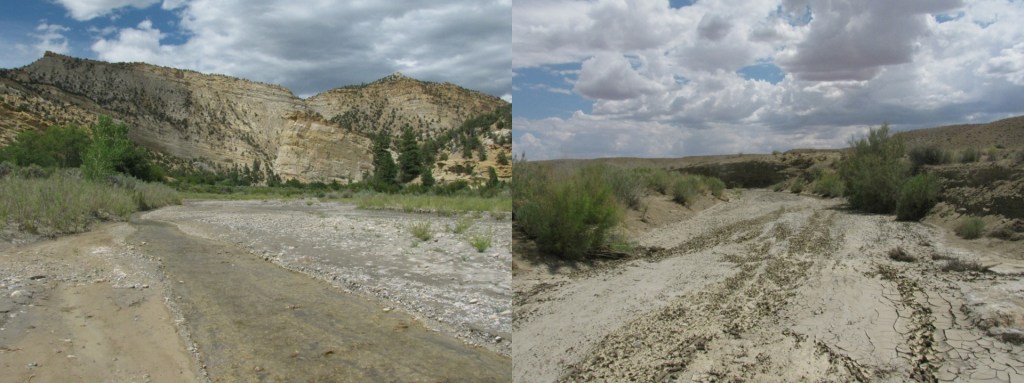What do you call a stream with no water? A wash? A gulch? An arroyo?
Whatever name you prefer, get ready to use it more often when you’re talking about the western US.
This region, where life is tied especially tightly to water, is projected to see faster-melting mountain snow packs and longer, drier summers.
And a new study, out in the Journal of Hydrology, examined long-term records of stream flow throughout the Upper Colorado River Basin to explore how low flows might get lower and how some channels might switch from perennial to intermittent. That is, from always having some flow to sometimes having none.
To do this, the researchers from Colorado State University and the USGS gathered data from 115 river reaches in Arizona, Colorado, New Mexico, Utah and Wyoming. Then, they related the number of zero flow days at a site to the climate features in the basin upstream as well as to the average and peak flows that we usually assess.
They found that zero flow days increased with drier values of the Palmer Drought Severity Index, a composite measure reflecting temperature, precipitation, soil moisture and evapotranspiration, and they found that the yearly average flow was a good predictor of the yearly minimum flow for both perennial and intermittent streams.
Perhaps most importantly, the data showed that streams with lower minimum flows and higher minimum flow variability are more vulnerable to the shift from perennial to intermittent.
So: what does this mean?
Well, these findings underscore the critical importance of continued streamflow monitoring. Gages – including those with valuable long-term records – are being retired due to funding constraints. But we can’t evaluate what we haven’t measured, and that cripples our ability to anticipate and adapt to changing water availability.
More proactively, knowing the increased risk of intermittency for locations with lower, more variable minimum flows could help us to prioritize conservation efforts. That could mean working to prevent losses at the most vulnerable sites or concentrating efforts around locations with a greater chance of persisting streamflow.
The southwestern US is a land of hydrologic extremes. Sudden desert thunderstorms can send a wall of water and boulders tumbling down river channels.
And the water can be gone almost as fast as it came, with floods followed days or even hours later by a placid trickle or no flow at all.
Life in the region has adapted to these sudden fluctuations. For example, researchers working in Arizona have documented via videos how insects such as giant water beetles will climb up and away from streams as it begins to rain. And the periodic droughts that affect the region have affected species over longer evolutionary timescales.
But these adaptations may not be enough in some locations, particularly if the shift from perennial to intermittent flow happens more quickly than the ability of freshwater plants and animals to relocate or if it follows other stressors such as invasive species or groundwater depletion.
These changes will certainly affect the values that we associate with rivers and riparian zones in the region.
Now is the time to think about how future streams may look and how we can adapt our practices to make sure thriving human and ecological communities don’t wash down the gulch.




Thousands of miles of Western rivers have already gone from perennial to intermittent, without the help of climate change. Western water law allows people to divert 100% of a river’s water, leaving the channel completely dry, and that happens all the time. Before TNC’s work on the Verde River, all of its flow was diverted. The Colorado River, once called the Grand River, is not so grand by the time it reaches Mexico — it’s a barren desert. The Salt River below intakes for Phoenix is dry as a bone. Even here in Montana, we see naturally perennial rivers go dry every year. The list goes on and on. That’s why we’re working with farmers, cities, and industries to change the timing, locations, and volumes of diversions so people and nature can share limited water resources wisely.
And citation:
Lindsay V. Reynolds, Patrick B. Shafroth, N. LeRoy Poff, Modeled intermittency risk for small streams in the Upper Colorado River Basin under climate change, Journal of Hydrology, Volume 523, April 2015, Pages 768-780, ISSN 0022-1694, http://dx.doi.org/10.1016/j.jhydrol.2015.02.025.
Great blog post! What is the citation of the article in Journal Hydrology you mentioned?
Dan,
Link should be fixed, but here it is…
http://www.sciencedirect.com/science/article/pii/S0022169415001377